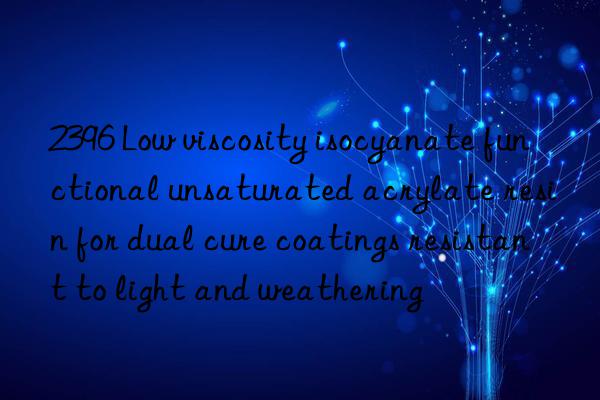
Product Description
2396 is a low viscosity Isocyanate-functional unsaturated acrylate resin based on hexaphenylhexamethylene diisocyanate for dual-cure coatings resistant to light and weathering
Key Features and Benefits
-minimal yellowing
- easy to combine with other photoinitiators Agent Mix
Chemical structure
acrylic isocyanate
Type Features
|
physical form 23°C (73° F) |
Low viscosity liquid |
(DINENISO3219)(Cut rate D6,700s-¹) |
|
Isocyanate content |
~ 14.5 – 15.5 % |
( D I N E N I S O 1 1 9 0 9) |
|
Platinum Cobalt (Hazelnut) Color No. |
≤ 150 |
(ISO 6271) |
|
Isocyanate Equivalent Weight (number of polymers 2396 Contains 1 mol active isocyanate as supplied) |
289.7-271.0 |
|
|
Density@50 °C (122 °F) |
~ 1.133 g/cm³ |
(DIN 51757, process 4.3 ) |
Solubility, Dilution Tolerance
You can use common paint industry Solvents (except aliphatic hydrocarbons) and reactive diluents such as low viscosity acrylates and vinyl ethers. NOTE: Viscosity may increase due to ingredients reacting with isocyanates, such as water and alcohols.
Butyl acetate and other esters can be used , ketones such as methyl ethyl ketone, ethoxyethyl glycol ether acetyl ester and xylene and other aromatic hydrocarbons are thinned.
Application
Polymer 2396 is a An isocyanate-functional aliphatic acrylate whose reactivity recommends it as an isocyanate and acrylate component for dual-cure applications.
As such, it is often associated with Hydroxyl resins or other radiation curable resins are used in combination, primarily in two-pack formulations. Dual-cure applications of 2396 can be weather and scratch resistant coatings. For pigmented coatings that cannot be cured by UV light, thermal pre-curing is required. Subsequent UV curing produces a coating with excellent weather and scratch resistance.
2396, a low viscosity Resin can also be used as the sole binder. After exposure to UV radiation, the isocyanate groups react with the ambient environment and the inherent moisture of the substrate to form a blister-free coating. Most notably, this one-pack application is suitable for porous substrates and substrates with poor adhesion properties.
Processing
2396 can be further diluted for processing . Suitable for low volatility monomers such as monofunctional, difunctional or trifunctional acrylates. Monomers are incorporated into the film, thereby affecting its properties.
Monofunctional monomers added Flexibility; difunctional monomers have little effect on hardness and flexibility, while trifunctional monomers increase the hardness of the cured film.
If there is enough flash area, an inert solvent can be used. However, these solvents must be completely removed from the film before exposure to radiation.
Crosslinking
2396 with hydroxy functional resin) e Combined use e.g., hydroxy-acrylic resin, hydroxy-polyester, hydroxy-polyether), aliphatic polyol or hydroxy-functional unsaturated acrylic resin.
Storage
Polymer 2396 should prevent Humidity, light and heat, and store in tightly airtight containers. 6 months when stored below 30°C (86°F). After opening the original container, the shelf life should be shorter.

 微信扫一扫打赏
微信扫一扫打赏

